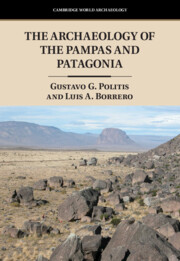Book contents
- The Archaeology of the Pampas and Patagonia
- Cambridge World Archaeology
- The Archaeology of the Pampas and Patagonia
- Copyright page
- Dedication
- Contents
- Acknowledgments
- Chapter 1 Introduction
- Chapter 2 Historical Background
- Chapter 3 Resources: Prey, Plants, and Stones
- Chapter 4 The Early Peopling: The Late Pleistocene to Early Holocene
- Chapter 5 The Middle Holocene (~ 8200–4200 cal BP; ~ 7500–3800 BP)
- Chapter 6 The Late Holocene Diversification (~ 4200 cal BP to ~ 400 cal BP; ~ 3800 BP to ~ 400 BP)
- Chapter 7 Final Remarks
- Select Bibliography
- Index
Chapter 6 - The Late Holocene Diversification (~ 4200 cal BP to ~ 400 cal BP; ~ 3800 BP to ~ 400 BP)
Published online by Cambridge University Press: 14 February 2024
- The Archaeology of the Pampas and Patagonia
- Cambridge World Archaeology
- The Archaeology of the Pampas and Patagonia
- Copyright page
- Dedication
- Contents
- Acknowledgments
- Chapter 1 Introduction
- Chapter 2 Historical Background
- Chapter 3 Resources: Prey, Plants, and Stones
- Chapter 4 The Early Peopling: The Late Pleistocene to Early Holocene
- Chapter 5 The Middle Holocene (~ 8200–4200 cal BP; ~ 7500–3800 BP)
- Chapter 6 The Late Holocene Diversification (~ 4200 cal BP to ~ 400 cal BP; ~ 3800 BP to ~ 400 BP)
- Chapter 7 Final Remarks
- Select Bibliography
- Index
Summary
During the Late Holocene time, regional differentiation, which became visible during the Middle Holocene, produced a wide variety of historical trajectories and adaptive patterns in the Pampas and Patagonia. It is clear that around 4000 BP human populations were selectively using all the diverse, available habitats. In this period, the archaeological visibility increased significantly, a fact that also suggests a rise in the population density of both regions (see discussion in Chapter 7).
- Type
- Chapter
- Information
- The Archaeology of the Pampas and Patagonia , pp. 194 - 244Publisher: Cambridge University PressPrint publication year: 2024

